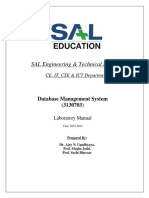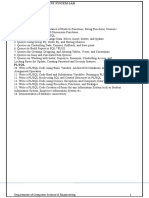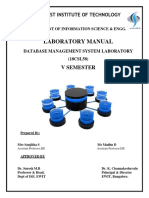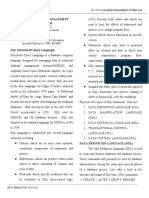0% found this document useful (0 votes)
92 views6 pagesSQL Lab Guide for Students
This document is a lab file submitted by a student named Arnav Preet for the Database Management Systems lab course at Delhi Technological University. It details Experiment 5 which aims to implement the Data Manipulation Language (DML) in SQL. The key DML commands - SELECT, INSERT, UPDATE, DELETE - are explained and examples are provided of creating a table and using each command to retrieve, add, modify and remove records from the table. The conclusion states that this experiment taught the use of DML commands to work with a database based on an entity-relationship model.
Uploaded by
arnav preetCopyright
© © All Rights Reserved
We take content rights seriously. If you suspect this is your content, claim it here.
Available Formats
Download as DOCX, PDF, TXT or read online on Scribd
0% found this document useful (0 votes)
92 views6 pagesSQL Lab Guide for Students
This document is a lab file submitted by a student named Arnav Preet for the Database Management Systems lab course at Delhi Technological University. It details Experiment 5 which aims to implement the Data Manipulation Language (DML) in SQL. The key DML commands - SELECT, INSERT, UPDATE, DELETE - are explained and examples are provided of creating a table and using each command to retrieve, add, modify and remove records from the table. The conclusion states that this experiment taught the use of DML commands to work with a database based on an entity-relationship model.
Uploaded by
arnav preetCopyright
© © All Rights Reserved
We take content rights seriously. If you suspect this is your content, claim it here.
Available Formats
Download as DOCX, PDF, TXT or read online on Scribd
/ 6


























































